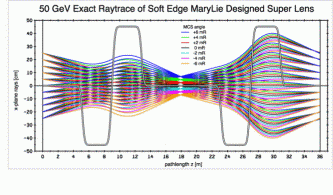

The code MaryLie 3.0 is described briefly below. Its features and use, with examples, are described in fuller detail in a 900 page Users' Manual. To download either the Table of Contents and Index of this Manual, or the Full Manual, click on one of the links below:
| Full Manual |
The code itself is available without charge to U.S. Department of Energy or other U.S. Government supported agencies/projects. For further information about such use, contact
| dragt@umd.edu |
For other purposes, a version is available commercially from AccelSoft Inc. This version has the added feature of a versatile graphical user interface. See the web site
| http://www.ghga.com/accelsoft/ |
Description of MaryLie 3.0
A new method, employing Lie algebraic tools, has been developed for the computation of charged particle beam transport and accelerator design. It represents the action of each separate element of a beam line or accelerator, including nonlinear effects, by a certain operator. These operators can then be combined, following well-defined rules, to obtain a resultant transfer map that characterizes the entire system.
Lie algebraic methods may be used for particle tracking around or through a lattice and for analysis of linear and nonlinear lattice properties. When used for tracking, they are both exactly symplectic and extremely fast. Tracking can be performed element by element, lump by lump, or any mixture of the two. (A lump is a collection of elements combined together and treated by a single transfer map.) The speed for element-by-element tracking is comparable to that of other tracking methods. When collections of elements can be lumped together to form single transfer maps, tracking speeds can be orders of magnitude faster.
In addition to single-particle tracking, Lie algebraic methods may also be used to determine how particle phase-space distribution functions evolve under transport through both linear and nonlinear elements. These methods are useful for the self-consistent treatment of space-charge effects and for the study of how moments and emittances evolve. They also provide a means for characterizing beams in terms of invariant eigen-emittances.
Lie algebraic methods also provide powerful means for carrying out analytic computations. Such computations include the calculation of tunes and first, second, and higher-order chromaticities and anharmonicities (dependence of tunes on betatron amplitudes) and first, second, and higher-order temporal dispersion (dependence of closed-orbit transit time on energy; sometimes called the phase-slip factor, and related to momentum compaction, the dependence of the closed-orbit length on energy); first, second, and higher-order ordinary dispersion, and all other linear lattice functions and their energy dependence through high order; nonlinear lattice functions; nonlinear phase-space distortion; transfer map normal forms; nonlinear resonance driving terms; nonlinear invariants; expected Fourier coefficients for tracking data; and moment data including eigenemittances and high-order moments.
Finally, Lie algebraic methods can be used to give an explicit representation for the linear and nonlinear properties of the total transfer map of a system. This information can be used to evaluate or improve the optical quality of a single-pass system such as a beam transport line or linear collider. For example, it is possible to design high-order achromats, aberration-corrected telescopes, and final focus systems. For a circulating system such as a storage ring, explicit knowledge in this case of the one-turn transfer map can be used to predict the ``linear'' aperture of the system, and the corresponding optimum tunes, without the need for long-term tracking. It is hoped that eventually knowledge of this map can also be used to make predictions about and optimize the dynamic aperture of the system. Indeed, some success has already been achieved in optimization.
The Lie algebraic methods described above have been implemented through third order in the Code MaryLie 3.0. It consists of a Main Program and approximately 500 Subroutines. Together they comprise approximately 40,000 lines of what is intended, wherever practical, to be standard FORTRAN 77 or 95 code. Moreover, to facilitate actual machine design, MaryLie 3.0 has extensive fitting, scanning, and optimization routines. These routines make it possible to fit, scan, and optimize essentially all quantities that can be computed by MaryLie 3.0, including those computed in user written subroutines. MaryLie 3.0 also provides full geometrical information including the orientation and location of all beam-line elements in 3-dimensional space.
A future code, MaryLie 7.1, is currently under development. It will carry out all the computations described above through seventh order. In addition, it will handle all magnet placement, alignment, and powering errors. There is no insurmountable difficulty in treating idealized beam-line elements in higher order. The major problem is the realistic treatment of fringe-field and magnet error effects, etc., which is essential for high-order expansions to make sense. [For example, some fourth-degree Lie generators are infinite for dipoles in the (unrealistic) hard-edge limit.] For this purpose, special routines will be included which make it possible to compute realistic transfer maps based on three-dimensional field data obtained either using codes such as OPERA-3d/Tosca provided by Vector Fields, or by direct measurement.